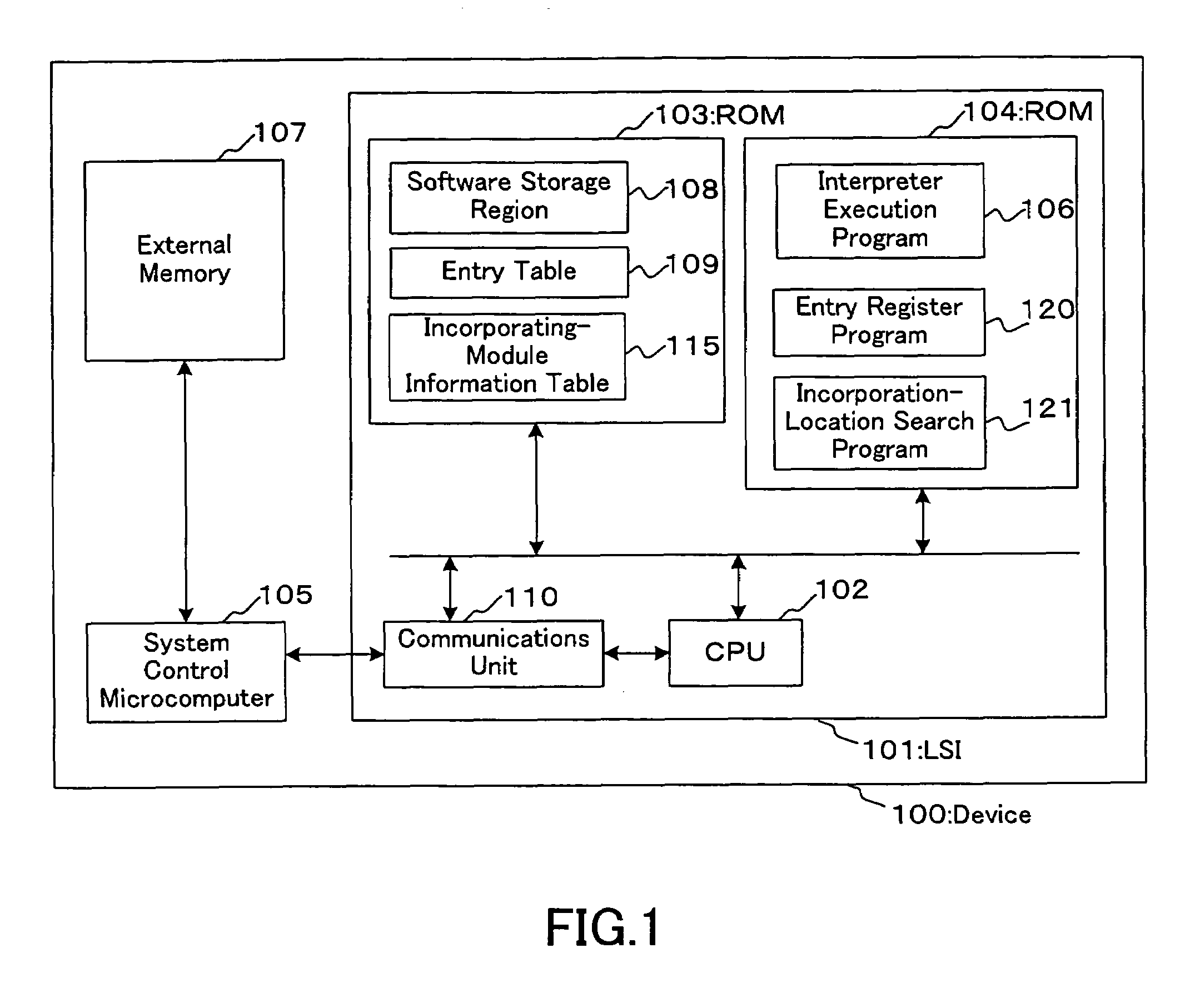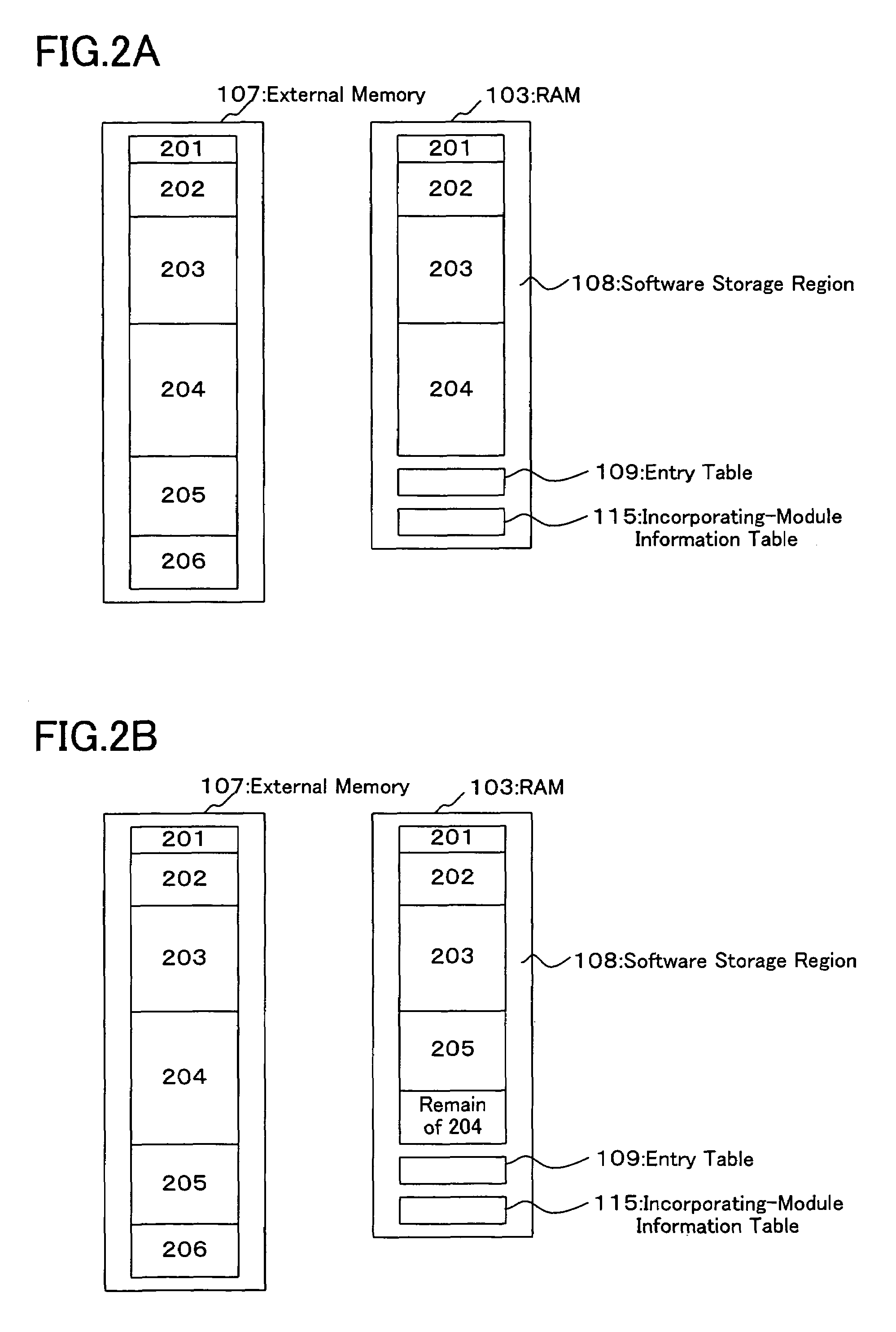CPU-containing LSI, and optical disk device and LSI device with the same
- Summary
- Abstract
- Description
- Claims
- Application Information
AI Technical Summary
Benefits of technology
Problems solved by technology
Method used
Image
Examples
embodiment 1
[0055]Embodiment 1 of the present invention is described below with reference to the drawings. FIG. 1 shows the configuration of a device according to the present embodiment, which is described below. Numeral 100 indicates a device according to the present embodiment. Numeral 101 denotes an LSI according to the present embodiment. Numeral 102 denotes a CPU that controls the LSI 101. Numeral 107 denotes an external memory in which software to be stored in a RAM 103, a program to be executed by a system control microcomputer 105, etc. are stored.
[0056]The RAM 103 can be accessed from the outside and includes at least the following three: 1) a software storage region, which is indicated with numeral 108, where software is to be stored, with the software being composed of an instruction sequence that is independent of the CPU and including a plurality of modules; 2) a table including entries (hereinafter, referred to as an “entry table”), which is indicated with numeral 109, where an en...
embodiment 2
[0097]Hereinafter, Embodiment 2 of the present invention is described with reference to the drawings. FIG. 6 shows the configuration of a device according to the present embodiment. As shown in FIG. 6, in the device according to the present embodiment, a program 122 is added to the ROM 104 of the device according to Embodiment 1. The program 122 is a program for erasing, from the entry table 109, an entry of an unnecessary module to be erased from the RAM 103.
[0098]With respect to the operation of the device according to the present embodiment, descriptions of the same parts as those in the device according to Embodiment 1 are not repeated herein. FIGS. 7A, 7B, 8A, and 8B show the configurations of modules of software stored in the external memory 107 and the module storage status of the RAM 103. Numerals 601 to 606 indicate modules. The descriptions of the parts shown in FIGS. 7A, 7B, 8A, and 8B and indicated with the same reference numbers as those used in FIG. 6 are not repeated ...
embodiment 3
[0121]Hereinafter, Embodiment 3 of the present invention is described with reference to the drawings. FIG. 11 shows the configuration of a device according to the present embodiment. As shown in FIG. 11, in the device according to the present embodiment, the entry table 109 is deleted from and two tables and one region are added to the RAM 103 shown in FIG. 6 illustrating the configuration of the device according to Embodiment 2, and two programs are added to the ROM 104 shown in FIG. 6.
[0122]One of the tables to be added to the RAM 103 is a compressed-module entry table 131 including entries of modules that have been compressed (hereinafter referred to as “compressed modules”). The other is an execution-module entry table 130 including entries of modules that have been expanded so as to be executed (hereinafter, referred to as “execution modules”) after the compressed modules are interpreted with an interpreter execution program. The region added to the RAM 103 is a compressed-modu...
PUM
 Login to View More
Login to View More Abstract
Description
Claims
Application Information
 Login to View More
Login to View More - R&D
- Intellectual Property
- Life Sciences
- Materials
- Tech Scout
- Unparalleled Data Quality
- Higher Quality Content
- 60% Fewer Hallucinations
Browse by: Latest US Patents, China's latest patents, Technical Efficacy Thesaurus, Application Domain, Technology Topic, Popular Technical Reports.
© 2025 PatSnap. All rights reserved.Legal|Privacy policy|Modern Slavery Act Transparency Statement|Sitemap|About US| Contact US: help@patsnap.com



